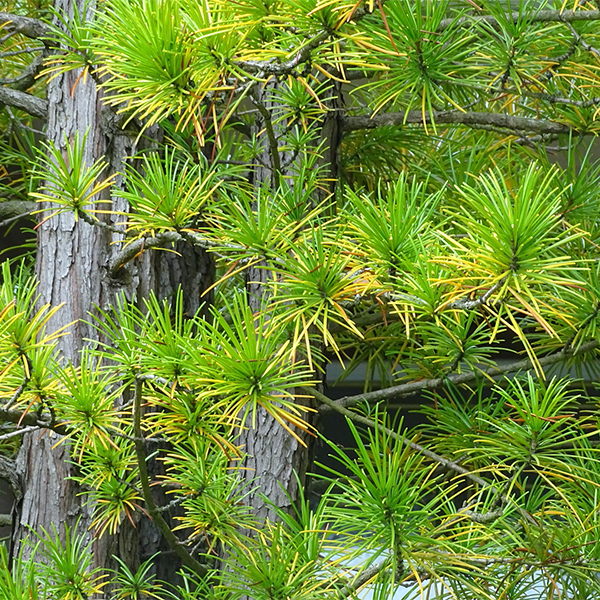
By R. Wayne Mezitt
When they first see it, some people think we’re showing them a plastic tree. Because the foliage of the Japanese Umbrella Pine is so thick and lustrous, it’s readily mistaken for artificial…until you get close and realize this is a living plant! And what a tree it is! Few hardy conifers compare to its stature and year-round beauty in the landscape. It’s well adapted to thrive most anywhere in the Northeast.
Sciadopitys verticillata is a majestic, unique, living-fossil, endemic to Japan, the sole representative of its 230 million year old botanical family. Interestingly (if you’re scientifically-minded, that is) its “needles” (held like the ribs of an umbrella—hence the name) are actually called “cladodes”; this is a technical term for a leaf-like structure that’s actually a photosynthetic branch (isn’t that a fact you didn’t know!?). Botanically Sciadopitys is not a true pine tree, although it looks similar (albeit on steroids!) and performs comparable functions in the garden. Still uncommonly seen in landscape design, some mature trees can be admired in this region growing around the homes of knowledgeable gardeners, on college campuses and in botanical gardens and some public parks.
With foliage perfect for use as cut-greens indoors or out, particularly around the winter solstice holidays, this is a great plant to enjoy near your home. Slow growing, eventually reaching 35 ft. and more tall and 20 ft. wide, it is maintenance and pest-free, tolerating most New England soils; just be sure you choose an area allowing plenty of space to grow. It provides a handsome backdrop for plantings in front or beneath and thrives in full sun. Mature trees show off their soft, fibrous-textured, orange-brown bark, making them attractive even when the lower branches are pruned-up.
Seed-grown trees are most commonly offered for sale in sizes varying from foot-high container-grown plants to specimens in the 8 ft. or larger range. The winter foliage on seed-grown trees tends to turn bronzy-green, a feature some homeowners appreciate, others find challenging. The cultivar ‘Wintergreen’ maintains its dark green foliage all year; it’s also a Cary Award winner, reasonably available at many garden centers, and a great value. Additional intriguing cultivars are being propagated, soon to appear on the market for the discerning gardener; some of these are more compact-growing or fastigiate, others boast thicker needles, variegated or golden foliage.
Finding Sciadopitys for sale at your local garden center may be a challenge, and because it is so slow growing when young, you can expect it to be more expensive than many other conifers of similar size. It’s encouraging that interest in Sciadopitys continues to expand as homeowners increasingly recognize how much value these trees add to their gardens and are now asking for them. Even some choice newer cultivars are steadily starting to appear on more availability lists from growers nationwide: ask your local garden center for more information and if they will order them for you.
Wayne Mezitt is a 3rd generation nurseryman, a Massachusetts Certified Horticulturist, now chairman of Weston Nurseries of Hopkinton, Chelmsford & Hingham MA, and owner of “Hort-Sense”, a horticultural advisory business. He currently serves in various capacities on several horticulturally-related organizations, including the Massachusetts Horticultural Society at The Gardens at Elm Bank in Wellesley MA, and chairman for the Massachusetts Invasive Plant Advisory Group (MIPAG).









